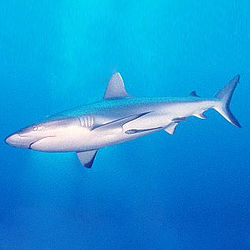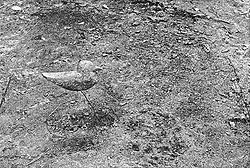
Countershading
Encyclopedia



Abbott Handerson Thayer
Abbott Handerson Thayer was an American artist, naturalist and teacher. As a painter of portraits, figures, animals and landscapes, he enjoyed a certain prominence during his lifetime, as indicated by the fact that his paintings are part of the most important U.S. art collections...
's Law, is a form of camouflage
Camouflage
Camouflage is a method of concealment that allows an otherwise visible animal, military vehicle, or other object to remain unnoticed, by blending with its environment. Examples include a leopard's spotted coat, the battledress of a modern soldier and a leaf-mimic butterfly...
. Countershading, in which an animal’s pigmentation is darker dorsally
Dorsum (biology)
In anatomy, the dorsum is the upper side of animals that typically run, fly, or swim in a horizontal position, and the back side of animals that walk upright. In vertebrates the dorsum contains the backbone. The term dorsal refers to anatomical structures that are either situated toward or grow...
, is often thought to have an adaptive effect of reducing conspicuous shadows cast on the ventral region
Abdomen
In vertebrates such as mammals the abdomen constitutes the part of the body between the thorax and pelvis. The region enclosed by the abdomen is termed the abdominal cavity...
of an animal’s body. In essence the distribution of light on objects that are lit from above will cause unequal reflection of light on a solid body of uniform colour; such shadows could provide predators with visual cues to a prey's shape and projection. Countershading therefore reduces the ease of detection of prey
Crypsis
In ecology, crypsis is the ability of an organism to avoid observation or detection by other organisms. It may be either a predation strategy or an antipredator adaptation, and methods include camouflage, nocturnality, subterranean lifestyle, transparency, and mimicry...
by potential predators by counterbalancing the effects of shadowing. Another form of counter shading is using bioluminescence this is called counter illumination
Counter-illumination
Counterillumination is a method of camouflage in which bioluminescent light from within an organismon the ventral surface is matched to the light radiating from the environment. The bioluminescent is used to obscure the organism's silhouette produced by the down-welling light. Some midwater...
and it is used to match the down welling light. It is a common practice in mid water fish, and invertebrates. It is used as a form of crypsis
Crypsis
In ecology, crypsis is the ability of an organism to avoid observation or detection by other organisms. It may be either a predation strategy or an antipredator adaptation, and methods include camouflage, nocturnality, subterranean lifestyle, transparency, and mimicry...
and believed to be primarily anti predator. It makes the species practically invisible form predators looking up.
Examples
Countershading is observed in a large variety of animals, such as pronghorn antelope, White-tailed deerWhite-tailed Deer
The white-tailed deer , also known as the Virginia deer or simply as the whitetail, is a medium-sized deer native to the United States , Canada, Mexico, Central America, and South America as far south as Peru...
, squirrels, bird
Bird
Birds are feathered, winged, bipedal, endothermic , egg-laying, vertebrate animals. Around 10,000 living species and 188 families makes them the most speciose class of tetrapod vertebrates. They inhabit ecosystems across the globe, from the Arctic to the Antarctic. Extant birds range in size from...
s, and various lepidopteran larvae.
Alternatively, in many marine animals (including various species of fish
Fish
Fish are a paraphyletic group of organisms that consist of all gill-bearing aquatic vertebrate animals that lack limbs with digits. Included in this definition are the living hagfish, lampreys, and cartilaginous and bony fish, as well as various extinct related groups...
such as marlin
Marlin
Marlin, family Istiophoridae, are fish with an elongated body, a spear-like snout or bill, and a long rigid dorsal fin, which extends forward to form a crest. Its common name is thought to derive from its resemblance to a sailor's marlinspike...
s and shark
Shark
Sharks are a type of fish with a full cartilaginous skeleton and a highly streamlined body. The earliest known sharks date from more than 420 million years ago....
s, penguins and cephalopod
Cephalopod
A cephalopod is any member of the molluscan class Cephalopoda . These exclusively marine animals are characterized by bilateral body symmetry, a prominent head, and a set of arms or tentacles modified from the primitive molluscan foot...
s) this form of camouflage may work through background matching; when seen from the top, the darker dorsal
Dorsum (biology)
In anatomy, the dorsum is the upper side of animals that typically run, fly, or swim in a horizontal position, and the back side of animals that walk upright. In vertebrates the dorsum contains the backbone. The term dorsal refers to anatomical structures that are either situated toward or grow...
area of the animal blends into the darkness of the water below, and when seen from below, the lighter ventral area blends into the sunlight from the surface.
Furthermore, countershading could also result from differential selection pressures on dorsal and ventral surfaces, from the need to protect against the damaging properties of UV light or abrasion.
History
Abbott Handerson ThayerAbbott Handerson Thayer
Abbott Handerson Thayer was an American artist, naturalist and teacher. As a painter of portraits, figures, animals and landscapes, he enjoyed a certain prominence during his lifetime, as indicated by the fact that his paintings are part of the most important U.S. art collections...
was one of the first to conduct extensive research on and to write about certain aspects of protective colouration in nature. In 1892, he wrote about the function of countershading in nature, in which he accounted for the white undersides of animals. For this reason countershading is sometimes called Thayer’s Law.
Military camouflage
Military camouflage
Military camouflage is one of many means of deceiving an enemy. In practice, it is the application of colour and materials to battledress and military equipment to conceal them from visual observation. The French slang word camouflage came into common English usage during World War I when the...
sometimes uses the same principle; Thayer even obtained a patent in 1902 to paint warships using a countershaded scheme.
See also
- Synodontis nigriventris, an "upside-down" catfish (with reverse countershading)
- Counterchanging, a heraldic device of similar appearance
- Counter-illuminationCounter-illuminationCounterillumination is a method of camouflage in which bioluminescent light from within an organismon the ventral surface is matched to the light radiating from the environment. The bioluminescent is used to obscure the organism's silhouette produced by the down-welling light. Some midwater...
- Theory of camouflageTheory of camouflageThe theoretical basis for camouflage is the underlying methodology used in camouflage, whether natural or human-made. The definition of camouflage involves concealment and obscurity, whether applied to the natural coloration of animals, or the paint schemes used on military vehicles...

